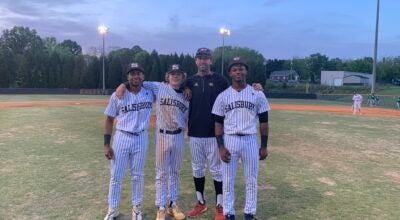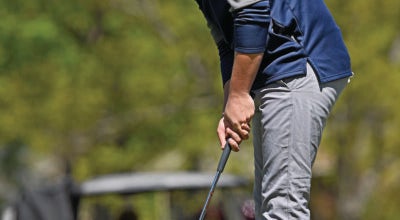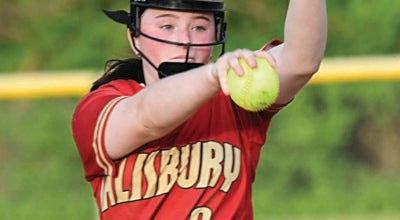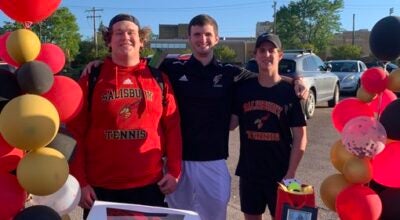Prep football: Friday Night Legend Rodney Callaway
Published 12:00 am Friday, September 4, 2009
The wheels that carried Salisbury’s Boyden High to a thrilling homecoming win against R.J. Reynolds 60 years ago are still in working order.
“My legs feel great,” said 78-year-old former end Rodney Callaway, the homecoming hero. “I tell my wife that if my heart was as good as my legs, I’d live forever.”Callaway and his teammates claimed a share of immortality in 1949. They won the first game played under the bright lights at Boyden’s new field ó a field we now know as Ludwig Stadium ó and did it by beating an unbeatable opponent.
Callaway, who competed in an era when everyone went both ways, is a reminder of a remarkable team with special players, most of whom have passed away. He still works ó as supervisor of officials for the North State Football Association.
He officiated on the football field, usually as the umpire, for 22 years. He handled three state title games and five Concord-A.L. Brown games. In Cabarrus County, those are bigger than state championships.
“Concord-Kannapolis was always a great ballgame on the field,” Callaway said. “Those teams played some football.”
Callaway has been a clinic leader for 35 years. For the past 21 years, he’s supervised officials, evaluating, grading and filing a report. He’s a modern man. Now he files his reports by e-mail.
Callaway has seen a lot of football, but the memory of 1949 hasn’t faded. He remembers coach Bill Ludwig’s voice and fullback Jerry Barger’s speed. He remembers the weather.
Except for a break when he was in World War II, Ludwig coached Boyden football from 1935 to 1958. His record was 129-67-11 with Boyden competing at the highest level against the state’s largest schools.
The 1949 season began like the others Ludwig orchestrated, with a military-style camp designed to instill toughness and trust.
Said Callaway, “You got up. You practiced. You cleaned up. You did skull work. You ate lunch. You practiced. You cleaned up. You ate dinner. You practiced. You slept.”
Three-a-days in the heat.
Ludwig was preparing to pound opponents with his single-wing offense while others were switching to the finesse-based T-formation.
He also was readying to battle schools such as R.J. Reynolds that might triple Boyden’s numbers.
“It was two weeks of intense football,” Callaway said. “But it was fun.”
Boyden was supposed to dedicate its shiny stadium against Lexington, but the field wasn’t quite ready. The opener was moved to Holt-Moffitt Field. Boyden’s Yellow Jackets won 13-0.
Calloway hurt his back in that game, but he was in the lineup for a trip to Gastonia for Boyden’s second outing.
“My junior and senior years, I probably was on the field all but two or three minutes,” Calloway said of the 1949 and 1950 seasons.
Boyden beat Gastonia 13-0.Barger, who achieved stardom at Duke, scored two TDs.”Jerry probably was the only natural athlete we had,” Callaway said. “The rest of us worked to play as well as we did. We were just want-to-play-ball boys, and Coach got the most out of us.”
Charlotte Central was next. It would be Boyden’s debut in its new stadium.
On Sept. 18, 1949, Boyden principal J.H. Nettles announced the stadium was finished, but there still was the matter of paying for a $10,500 lighting system.
The Salisbury Jaycees handed over a check to the Salisbury School Board in the amount of $7,500. The $3,000 shortfall was eliminated by selling 600 reserved seats at $5 a pop. Mayor Cliff Peeler was the first to purchase a seat.
The game with Charlotte Central was set for Oct. 7. Charlotte Central was 5-0 and one of the top teams in the South. It already had beaten Greensboro, Fayetteville, North Charleston, S.C., and Atlanta.
Few gave Boyden a chance, but the Post’s Horace Billings predicted the Yellow Jackets would prevail 14-12, and 5,500 fans, more than capacity, poured into the bleachers.
“The stadium was dedicated, and it rained all night,” Calloway said. “Charlotte Central came out wearing plastic pants, and they looked sharp. Coach Ludwig told us all that would do was wear their legs out, and he was proven right.”
Boyden won 6-0. Bill Peeler and Jerry Kincaid blocked a punt. Paige Lyerly fell on it at Charlotte’s 44. Barger took charge from there. He pounded in the only score of the game.
It was a monumental victory, but Boyden was still floating on a cloud and lost to High Point the next week. It was Boyden’s only loss of the regular season, but that one letdown, combined with a scoreless tie with Burlington, cost the Jackets a conference title.
The last game of the 1949 regular season was homecoming against R.J. Reynolds. The last thing on Callaway’s mind was catching a touchdown pass.
“We were 3 yards and a cloud of dust,” he said. “As an end, I was a blocker. My assignment was almost always a double-team block with our wingback.”
Sonny Ridenhour, the Reynolds star, put his team ahead 6-0 right away.
Boyden struck back in the second quarter when Barger flipped a surprise 12-yard pass to the fleet Callaway, who turned it into a 50-yard scoring play to make it 6-6.
“Ridenhour was the safety when I caught that ball, and I was afraid of him hitting me,” Callaway said. “When you run scared, you can run fast. That play thrilled me to death.”
Peeler’s PAT provided a 7-6 victory.
Callaway was good enough to get a scholarship to South Carolina. His career lasted only weeks, but he had a highlight.
“I was trying to play defensive end at 170 pounds and broke my arm pretty bad,” he said. “But I did get to play against Duke and tackled Barger for a loss. Jerry had already told me if I got in the game he was running the option at me. I reminded him he never had been able to run by me.”
Callaway received “an invitation” to the war in Korea from Uncle Sam not long after that game. He entered the Air Force and worked with radar and air-to-air missile systems that were on the cutting edge of technology.
He married Julia Cohen, also a member of Boyden’s Class of 1951, while he was in the service. When he got out, he went to work for her father’s plumbing company.
They’re still a team after 57 years of marriage.
Al Saleeby, Boyden’s 1941 Shrine Bowler, urged Callaway to try officiating, and he got his start working youth games in Spencer.
He wore the zebra-stripes proudly for decades and will grade officials at tonight’s Concord-East Rowan game.
Callaway’s legs are still good. So is his heart.
“I’ve been able to help a lot of officials get started,” he said proudly. “My officiating career is something I really feel good about.”





